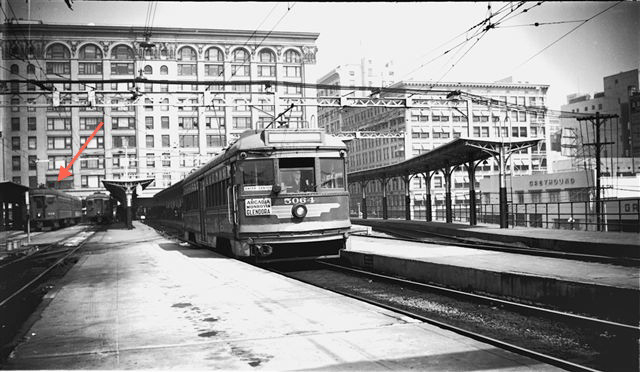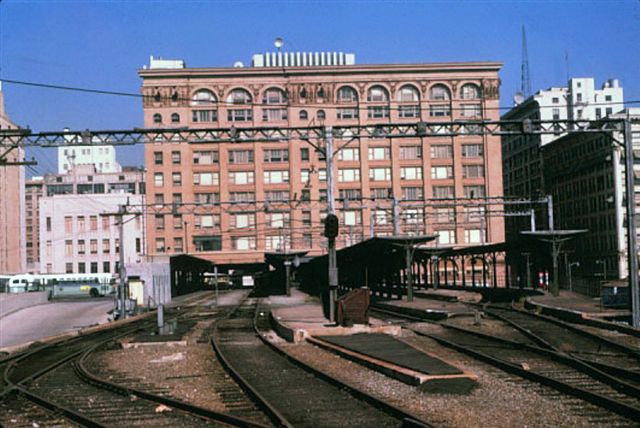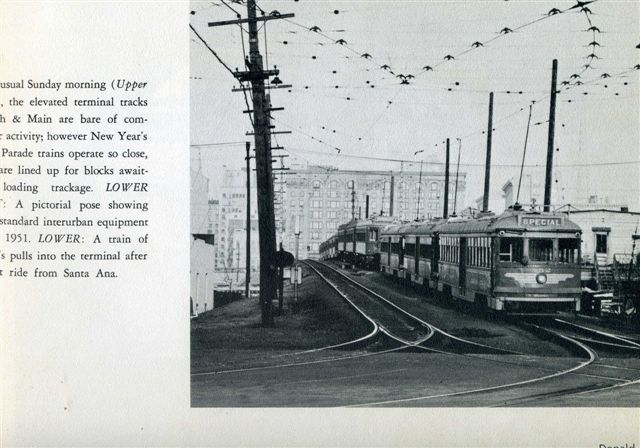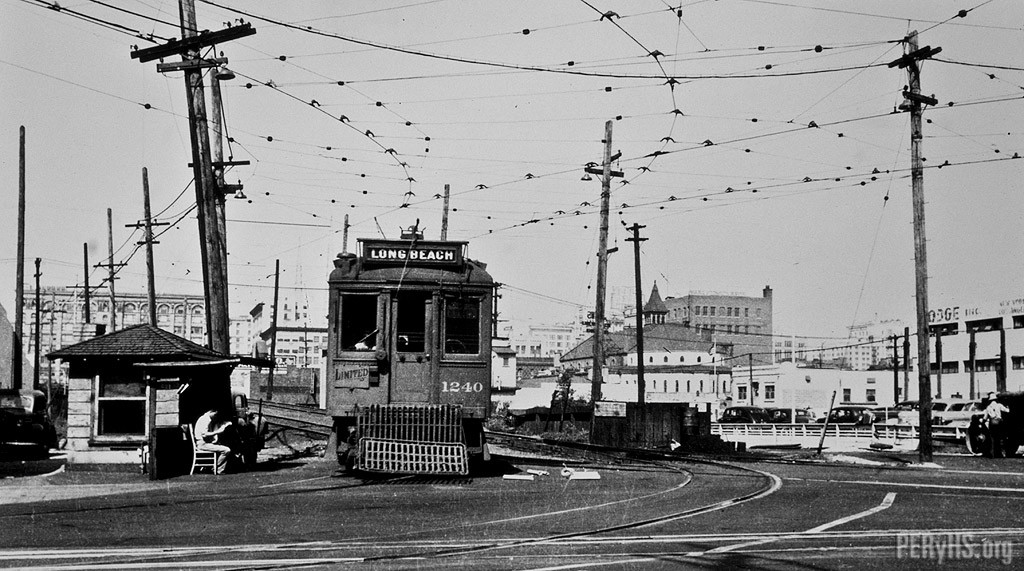Pacific Electric’s Rear Tower at 6th and Main
By Ralph Cantos
In this image, Pacific Electric Hollywood car no. 5064 departs the 6th & Main Street elevated station for Glendora. Time was running out for the Northern District by this Summer 1951 photo. The 1100s were now in dead storage at the West Hollywood yard awaiting sale to Buenos Aires, and the Hollywood cars would ring down the final curtain on the North in September.
What makes this photo interesting is that it clearly shows the “REAR CONTROL TOWER” (note the red arrow) that operated all the electric switches on the elevated, including the North-South switches at the base of the ramp on San Pedro Street. The Tower can be seen just above Blimp no. 318, it’s the window with the awning on it.
I was lucky to visit the Rear Tower a few times and found it a very interesting experience. Until the 1951 abandonment of the Northern District, the tower man had his “hands full” pulling the large brass levers that protruded from a large wooden cabinet. Soon after the Northern District abandonment, the switch at the base of the ramp was removed and replaced by a east-to-south curve. When the Watts Line was abandoned at the end of 1960, there was little or no need for the tower man to operate the levers except for a few hours during morning and evening rush hours, and on April 9th, 1961, the tower man got the boot.
Alan Weeks Photo, Ralph Cantos Collection
And here’s a photo of the platform after abandonment, in 1962:
More from Ralph:
PE electric switch a the base of the elevated: There seems to be some disagreement on how the electric switch was operated at the bottom of the 6th & Main elevated ramp. In this 1949 Donald Duke photo taken from across the street, I do not see a “switchman’s shanty” anywhere . The logical location for such a structure would be at south side of the ramp. I don’t see any trace of such a structure in this photo. When I use to hang around the 6th & Main terminal.
I noticed a small “booth” next to the southern most terminal track that may have been used for dispatching and communication to the Rear Tower. The PE employee in the booth would let the Tower man know the destination of the departing train, so the switch at San Pedro St could be set in the proper direction. I did not arrive on the scene until 1957 and by then the switch at San Pedro St was long gone and the little booth stripped of all electrical equipment.






in the 1962 post abandonment photo, the “Rear Tower” window can been seen.
Somewhere I have a photo of my daughters running along the ramp; this may have been right after the OETM crew salvaged one of the puzzle switches from the terminal. Note the 5050-class car with a dash sign for the Monrovia-Glendora Line. Usually, this line had cars 732-759, the set that was never modified into 5050s and went to Argentina. One of the Saturday mornings when my brother and I went from Monrovia to San Marino to meet our dad at the Post Office, the car on that run was a 5050, and we were disappointed because it didn’t have the “railfan seat” up front, just a toolbox with a sloping lid. We like to ride by the motorman, and he’d let us off through the front door. We boarded at the center doors because that’s where the conductor was, and there’s a sign in the front window of 5064 that probably reads “Enter Center”.
Hired out on the SP railroad in 1964 and completed everything at the P.E. Building. Had been there many times during the PE days in the early 1950’s. My father was a Streetcar operator for the LA Rwy/LATL from 1943 until his death in 196; the last few years as a Bus driver.
Hi Ralph, many thanks on how train movements were controlled at 6 th and Main st. question: after the 1st of oct ’51 termanation of all passenger ops on the northern division..it appears the box motor ops to Union Station continued for a while after that, if so, how much longer, and to what extent…
Ralph I too spent many wonderful hours in the dispatch area! My dad who was with the SP would take me down to the tower room and set me up on a big stool where I could watch all the action. Those were the days.
There was also a tower on the Main Street side of the PE building. It was in a bay window just south of the train entrance into the station. Page 104 of vol III of Donald Duke’s multi-volume books on the PE shows this front interlocker complete with lower quadrant semaphores. This tower controlled PE cars entering and exiting the Main Street entrance to the PE station along with governing LARY traffic on Main Street.
I seem to remember a switchman and shack at the foot of the viaduct at San Pedro St. to control the switches to and from the station. It would have been difficult for the “tower” switchman to see what is going on on San Pedro St.
There was a small wooden shack for a PE flagman/switchman stationed at the base of the ramp. He was there more for safety reasons. There were 2 manual crossovers on San Pedro St. just north and south of the ramp. The flagman would flag the many trains that came down the ramp. load newspapers aboard trains and operate the manual switches in the street. But the north , south switches at the ramp base were operated from the Rear Tower. With the 1951 abandonment of the Northern District, the swithces were removed as was the flagman and his little “dog house”.
An interesting note on Towermen can be found on page 58 of the “Agreement between the Los Angeles Metropolitan Transit Authority and the Brotherhood of Railroad Trainmen” union agreement of May 7, 1962:
“The parties agree that should the Authority, in the building of mass rapid transit, again require the use of Towermen, that they shall negotiate the wages, hours and working conditions for this classification of work. The parties agree that Towermen or any classification of work similar thereto, is under the jurisdiction of the Brotherhood.”
As noted in previous posts, the Towermen got the boot just over one year before the new union agreement became effective. The Brotherhood was indeed looking forward, while the Authority was destroying the future. In less than a year, the union agreement would change in its entirety with the abandonment of the LAMTAs rail operations.